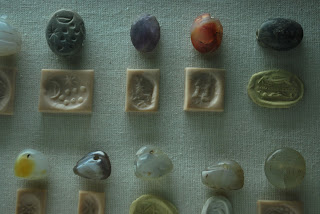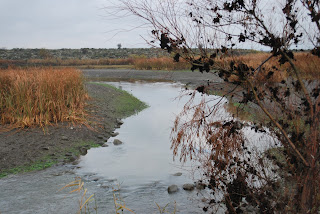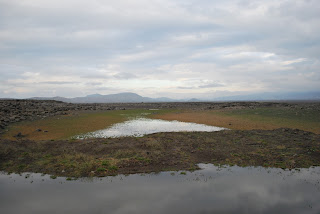Off to Gaziantep for the weekend - famous for its strategic location along the silk road that made it the perfect settlement throughout history, and of course, its pistachios and baklava (and Gaziantep kebab but I discriminate against meat dishes, apparently). We left Istanbul smoggy and early on Friday morning, under a dusting of...snow! This made me very happy, with Christmas one week away, and little semblance of the Holiday season here, the snow provided just the right ambiance.
 |
| view out the bus window |
We got into Gaziantep mid afternoon and head to the Archaeological Museum, which contains many of the goods found at the Hellenistic/Commagene/Roman/Sassanian/Byzantine site of Zeugma which I will describe to you later. Here are some of the remains, most of which are from the Roman period:
 |
| very famous "Gypsy Girl" mosaic, found at Zeugma |
 |
| I just liked this guys' style |
 |
| bulla (stamp seals) made of different types of stone |
 |
| coins |
 |
| what a coin would buy you, back in the Roman day |
 |
| gotta have tools! |
 |
| nice pitchfork of some kind |
 |
| sculpture of a lady |
 |
| elephant jaw |
 |
| elephant bones |
 |
| toys! |
 |
| lemon juicer? |
 |
| the spear-like objects may be the traditional steaks still used to roast kebab |
After the museum we went to dinner
at one of the more well-known restaurants in Gaziantep, with traditional dishes. We ran into a wedding party celebrating the engagement - in Turkey the engagement is also celebrated, usually with a big, fancy dinner. We ran into such a party - Nitsa, my friend who just got engaged, swears she will not wear the sparkly dress that is popular among many
enfianced. I secretly hope she wears a super sparkly dress. Anyway, back to dinner!
 |
| Ayran: a Turkish yogurt-based drink definitely is either loved or hated by those that try it. it is a light and salty yogurt drink, so it's quite different from the sweet yogurt Westerners are used to. I have learned to love combining yogurt and savory food... |
 |
| Ozge having her ayran |
 |
| salad mezzes and this dish at the bottom is skinned and baked eggplant, covered in yogurt and then a spiced hot oil is poured on top. delicious. |
 |
| baklava - my phone camera does not do it justice! must not be embarassed to use digital camera at proper dinner tables |
After dinner our first night we went for a lovely walk through the historic district, and we passed the castle. Gaziantep is located on an acropolis - the first settlements here pre-date the Neolithic period, and starting from the Hellenistic period the acropolis was used as an integral part of the urban structure.
 |
| entrance to an Ottoman marketplace |
Day 2 Sites: Tilman Huyuk, Yesemek, Tasli Gecit
I almost forgot how nice it is to stay in a hotel, where they make your bed, give you fresh towels and of course, a hearty (free) breakfast...
 |
| Turkish "villagers breakfast": hard-boiled egg, cheese, tomato, cucumber, olive, fresh bread, missing they honey and creme-fraische-like cheese. |
So we went off to see three sites today in our handy bus
 |
| driving through the clouds on the side of a mountain |
 |
| on our way to the first site |
Tilman Huyuk:
 |
| pebbles on the walkway to |
As we walked onto Tilman Huyuk, we immediately noticed the beautiful rocks/pebbles under our feet.
 |
| sideways photo of pebbles arranged to say "lovers never die" in Turkish...perhaps park security should be upped |
 |
| the house is flooded! |
The topography of the area was very interesting ' dark soil, dark branches with luminous orange and green foliage, in December.
 |
| super cool contrast in the trees |
Yesemek: the open-air park of unfinished sculptures:
The settlement that lived here in late antiquity produced unfinished sculptures, of which the remains were found dispersed along this hillside. It is now an open air "arkeo-park", meaning a place to come and see
insitu, or "on site", archaeological finds - in keeping with the idea that it is best to see these items in their original placement, not in a museum. The first part of the park has been arranged in an almost yogi-style meditation park, with rows of the sculptures set up on ascending Mayan-like levels.
 |
| pretty fountain |
 |
| view of the local town |
 |
| unfinished relief sculpture |
Up the hill above the arranged sculptures, we were able to see the natural landscape, containing other sculptures that have not been moved from the way in which they were found. I thought this was pretty cool...
 |
| I also like the moss... |
 |
| view of a group of sheep being herded on the road - the two figures at the end are "kangal" dogs, or as my dad called them, Turkish shepards; huge and very loyal dogs. |
 |
| relief of a man and woman |
We then left the Yesemek open air park and crossed the road, to where a modern open air sculpture exhibit is located. From the little Turkish I can understand, students from different Turkish Universities came and worked on the following sculptures. They are very cool sculptures, and they were completed in under a month.
 |
| cowboy hat |
 |
| bison horns |
 |
| sculpture of a lady's backside |
Back on the road...
Asking for directions from a neighborly car of Turks...
Passing a tractor....
and some sheep...
Tilman Huyuk:
We found these rocks everywhere, that reminded me of moon rocks, or what I think moon rocks would look like.
Things got kind of muddy
This is what happens when you have excessive amounts of mud on your shoes and then step on little rocks - thanks for the demo, Nitsa!
 |
| the site |
 |
| my friend (and colleague) Nitsa |
 |
| we thought this was an alien symbol, as well, but turns out it was just some crop rotation planning...my colleague Ozge went to go check it out... |
 |
| view from the site off into the mountains |
 |
| modern art sculpture marking the entrance/exit from the site |
 |
| beautiful, snow-covered mountains off in the distance on our drive back to Gaziantep |
Day 3: Castle Panorama Museum, Gaziantep Kitchen Museum, Zeugma and Crossing the Euphrates
 |
| bronze sculpture of mother and son, sad story here |
 |
| minaret with inlaid plate decorations |
 |
| street in Gaziantep |
 |
| "Gaziantep Kitchen Museum" |
 |
| copper flask |
 |
| possible cultural heritage management thesis topic? |
 |
| olives, olives, olives |
 |
| Add caption |
 |
| typical day in the city center by the old acropolis |
 |
| inside the marketplace (han), still being used |
As we observed the marketplace (han), a man on a tractor decided to come in an park his vehicle in the historic marketplace. He received help from fellow friends in doing his 9 (plus) point turn.
 |
| people got involved in helping the tractor park |
 |
| Nitsa on the other side of the han |
 |
| silhouette of our British archaeologist friend who accompanied us on the trip |
 |
| uncured olives - inedible! |
 |
| sundried tomatoes hanging outside a shop |
 |
| man hanging outside his shop |
 |
| man and his tea shop |
 |
| these dried peppers and eggplant are used to make "dolma" here, which entails their being stuffed with rice and veggies or meat and being baked. A very common diet staple. |
 |
| watermelon seeds |
 |
| the makings for the birds-nest-like pastry used to make delicious sweets |
Baklava from Gaziantep, as I have mentioned, is quite famous. So much so that a baklava shop will consist of a little shop with two or three of these platters in the front window. The shop will be tended by one or two men, in white, doctor-like coats. Baklava is serious business here.
 |
| baklava shop |
 |
| shopkeeper taking care of his produce |
 |
| Gaziantep had a lot of buildings that had been destroyed or damaged by fires |
 |
| fancy restaurant for lunch |
 |
| yogurt-based soup with dough ball, (meat) and spinach, and of course drizzled with butter |
 |
| this is the prepared version of the dried eggplant and peppers shown in a picture above |
 |
| yogurt with spinach and garlic, topped with fried little dough balls |
 |
| soup! |
 |
| another feast of mezze |
Aside from Baklava, Gaziantep is famous for its pistacios. Below is a cup of "pistachio coffee" - with no actual coffee, as far as I could tell. It was more like a creamy pistachio-flavored drink.
 |
| Add caption |
Zeugma:
When we arrived at the last site of our weekend, we came across some very hungry canine friends.
So we fed them cheese and bread we had stored in our bus.
Approaching the site...
Zeugma was founded in 300 B.C. by Hellenist ruler, Seleucus I Nicator. He called it Seleucia on the Euphrates, where it occupies a prime coastal position. He also founded Apemia, its sister city, in honor of his Persian wife. Apemia is located on the Eastern side of the Euphrates (we went over the Euphrates to Apemia after visiting Zeugma, but it was too dark for good photos).

Seleucus of the Euphrates was conquered in 64 B.C. with the disintegration of the Seleucid Empire to Antiochus I of Commagene, and "Zeugma", as it was called (meaning bridge) was one of four main cities of the Commagene Empire. Zeugma became an important base for the Roman IV Legion of Scythica. Once again a Roman settlement, it became an important military, economic and cultural center. Located on the silk road, connecting Persia to Anatolia, lavish Roman villas were built, the remains of which were the subject of excavation beginning in the late 1980s - and turned into rescue excavations in 2000 as the building of the Birecik dam threatened the preservation of the site.
Today the mosaics and goods from the site can be seen in the Gaziantep museum. (see pictures at very top)
 |
| acqueduct - the Romans knew what they were doing |
Zeugma has great potential to be a great site for tourism that would economically benefit the local population. Obviously there are mixed feelings about the development of this area, but it seems a shame to me the way it is so overlooked and isolated today...
 |
| pristine location on the Euphrates |
 |
| back to Istanbul, over the Taurus mountains |




































































































































